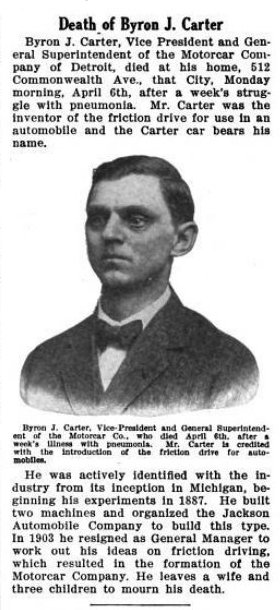

|
Byron Carter and the Self-Starter |
 It has been widely reported that the death
of Byron Carter was the genesis of the creation of the electric
starter for automobiles. The biography of Charles Kettering, the
man who ultimately built the first production electric starter,
records the story as follows:
It has been widely reported that the death
of Byron Carter was the genesis of the creation of the electric
starter for automobiles. The biography of Charles Kettering, the
man who ultimately built the first production electric starter,
records the story as follows:
In the summer of 1910 a woman driving an automobile across the old Belle Island Bridge in Detroit, stalled her engine.... A man who happened by just then stopped and offered to crank the woman's engine for her. He was Byron T. Carter, maker of the automobile called the Cartercar. Unfortunately the spark was not retarded. So the engine kicked back and the flying crank broke Carter's jaw.... Carter was not a young man, and complications arising out of the accident caused his death. Now, it happened that Carter was a friend of Henry Leland, head man at Cadillac. Soon afterward, in Leland's office, Kettering remarked that he thought it would be possible to do away with the hand crank, sometimes called the 'arm-strong starter,' by cranking cars electrically. In Leland's distress at the loss of his friend Carter, he took up the suggestion at once.Kettering's biography is the earliest known account that mentions Byron Carter in the cranking accident. It was published in 1957, a year before Kettering died, but nearly 50 years after the death of Byron Carter. A similar account of the story appears in a 1957 GM publication called 'Adventures of the Inquiring Mind.'
An elderly friend of Henry M. Leland, founder of Cadillac, was driving a Cadillac on the Belle Isle bridge when the motor stalled. Forgetting to throw out the clutch before cranking the car, he sustained serious injuries. Mr. Leland's grief over this accident drove him to encourage Kettering, and to give the Delco starting, lighting, and ignition system a chance.Does it make sense that Byron Carter would be driving a Cadillac instead of the car bearing his name and would he at age 44 be considered elderly?
H. O. Carter, representing the Carter International Automobile Manufacturing Co., of Milwaukee, with a local office, met with a peculiar and painful accident at Belle Isle yesterday afternoon. With John C. Voll, traveling man, and a number of other friends, Mr. Carter was driving his auto on the Canadian shore of the island when he observed another machine in distress. Mr. Carter stopped his own machine and went to the relief of the stranded party. He was manipulating the crank bar, when the contrivance slipped, striking him a violent blow in the jaw. The injured man was first conveyed to the Marine hospital, where his face received temporary dressing. As the hospitals were unable to provide private quarters for the patient, Mr. Carter was taken to his room at the Griswold house, where he is being cared for by Dr. Wright. His jaw is badly fractured.
 The Washington Post account adds more detail on the injuries: "The left side
of his head was crushed. A section of his cheek bone was extracted Sunday night
and he is very weak from loss of blood. It is expected, however, that he will
recover."
The Washington Post account adds more detail on the injuries: "The left side
of his head was crushed. A section of his cheek bone was extracted Sunday night
and he is very weak from loss of blood. It is expected, however, that he will
recover."